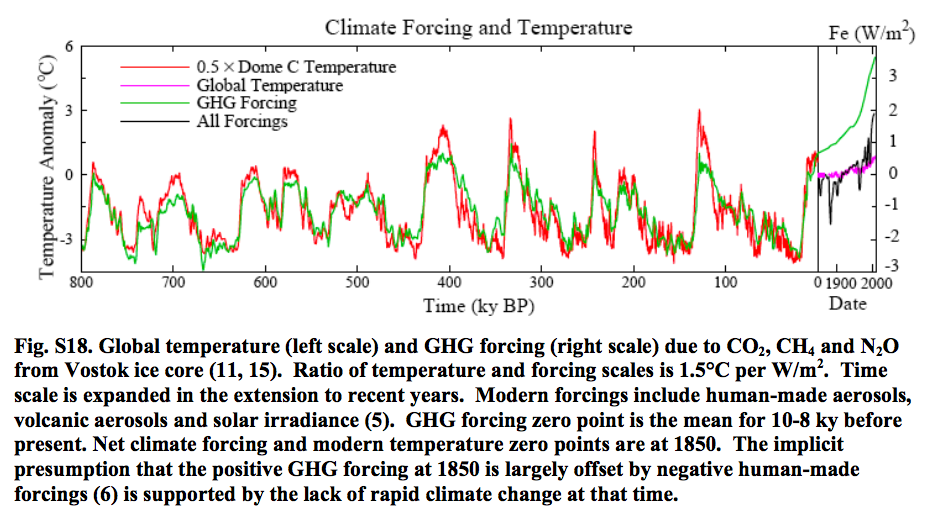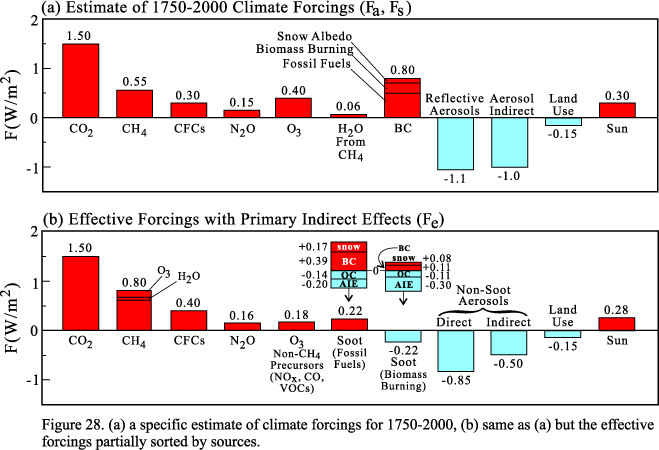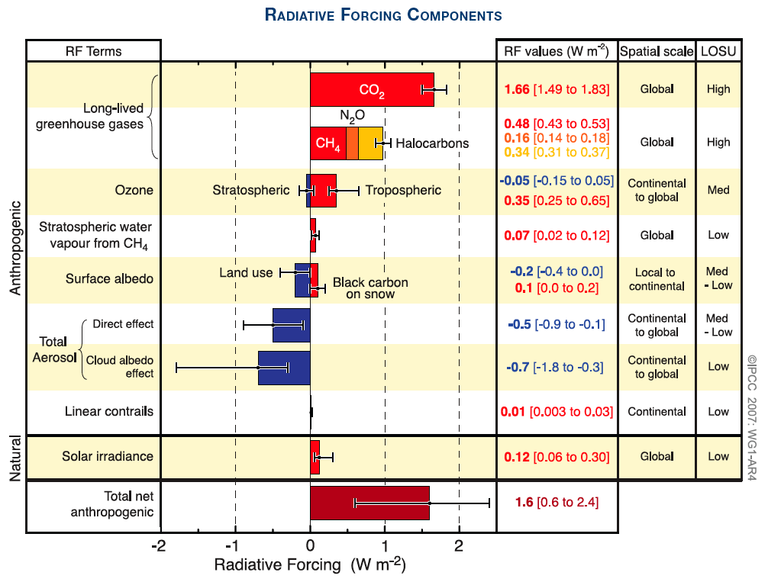Climate Forcing
Climate forcing has to do with the amount of energy we receive from the sun, and the amount of energy we radiate back into space. Variances in climate forcing are determined by physical influences on the atmosphere such as orbital and axial changes as well as the amount of greenhouse gas in our atmosphere.

Climate Forcing
Climate forcings are a major cause of climate change. A climate forcing is any influence on climate that originates from outside the climate system itself. The climate system includes the oceans, land surface, cryosphere, biosphere, and atmosphere.
Examples of external forcings include:
- Surface reflectivity (albedo)
- Human induced changes in greenhouse gases
- Atmospheric aerosols (volcanic sulfates, industrial output)
These examples all influence the balance of energy entering and leaving the Earth system. These types of forcings are often referred to as radiative forcing and can be quantified in units of the extra energy in watts per meter squared (W m-2) entering the Earth near the top of the atmosphere (TOA).
Not all climate changes are caused by climate forcings, however. Climate is intrinsically variable and can change even if there is no external forcing. An unforced change would be some kind of natural shift like an El Nino. El Nino events tend to cause atmospheric warming because they are transporting heat from the ocean back into the atmosphere. This happens even though there is no change in solar output or other external forcing.
Climate forcing must generate a response, the same way a mechanic force causes an object to move. A positive radiative forcing involves shifting the balance such that the Earth gains heat and the climate warms. As the climate warms, the Earth will emit more infrared radiation to space, but this change at the top of the atmosphere is a response to the forcing, and not a new forcing. Warming will continue until a new balance is achieved between energy gained and lost at the top of the atmosphere.
Understanding climate forcing is actually easy. Think of it this way. If you are standing and someone begins to push against you, initially you may start to fall over. This is a state of imbalance due to the forcing imposed on you. Your natural reaction is to readjust your posture to push back (and avoid falling over). If the person keeps pushing, you will need to keep pushing back. The forcing is the initial push, your reaction is the response.
Climate Response
The Earth reacts to positive radiative forcing by warming up until a new balance is achieved at a higher temperature. This new steady state is actually a forced steady state as opposed to an unforced steady state, which would be the natural state without the human induced forcing.
The rate at which the Earth’s climate warms in response to positive radiative forcing depends on several factors besides just the forcing. A major factor is the thermal inertia of the ocean which slows the response because the ocean can store a lot of heat. It takes a long time to warm the ocean, just as it takes a long time to cook a turkey. The temperature of the atmosphere is also influenced by the oceans, so the slow warming of the ocean also slows the warming of the atmosphere.
The National Academy of Sciences, National Research Council, Board on Atmospheric Science and Climate Present:
‘Climate Change: Lines of Evidence – How Much Warming?’
Changes in Climate “Forcings”
A number of processes are now contributing to forcing the Earth’s climate away from a natural state. To get a sense of the net effect, you can add all the components of forcing that are positive and negative and you end up with a view of the total forcing in the climate system of Earth.
The following figure shows changes in climate “forcings” or factors that have contributed to climate change since 1750, before human influences on climate were very significant.
These agents can be categorized into three areas: greenhouse gases, other man-made (anthropogenic) forcings, and natural forcings. The greenhouse gases consist of carbon dioxide (CO2), methane (CH4), nitrous oxide (N20) and chlorofluorocarbons (CFCs). Other anthropogenic forcings consist of black carbon (soot, formed by incomplete combustion), reflective aerosols (tiny airborne particles that reflect sunlight back to space), soil or dust, land cover changes, and forced cloud changes. Natural forcings include changes of the sun’s energy.
Figure is also available in PDF format. (Source: Figure 28 of Hansen et al. 2005. See references below.)
IPCC AR4 Forcing Components
Source: https://data.giss.nasa.gov/modelforce/efficacy_fig28.gif
Effective Forcings Employed in Current Climate Simulations
The following figures show effective global climate forcings employed in our current global climate simulations (e.g., Hansen et al. 2007a,b), relative to their values in 1880.
(a) The separate radiative forcing data are available as a text file. The figure is also available as a large GIF or PDF.
(b) The net forcing data are available as a text file. The figure is also available as a large GIF or PDF.
Further Details and Various Future Scenarios to 2100
References
- Hansen, J., L. Nazarenko, et al. 2005a. Earth’s energy imbalance: Confirmation and implications. Science 308, 1431-1435, doi:10.1126/science.1110252. (See also Imbalance webpages).
- Hansen, J., M. Sato, et al. 2005b. Efficacy of climate forcings. J. Geophys. Res., 110, D18104, doi:10.1029/2005/JD005776. (See also Efficacy webpages).
- Hansen, J., et al. 2007a. Dangerous human-made interference with climate: A GISS modelE study. Atmos. Chem. Phys., 7, 2287-2312.
- Hansen, J., et al. 2007b. Climate Dynam., Climate simulations for 1880-2003 with GISS modelE. Climate Dynam., 29, 661-696, doi:10.1007/s00382-007-0255-8.
Links
General
- https://data.giss.nasa.gov/modelforce/
- https://climate.nasa.gov/uncertainties/
- 2009 https://www.realclimate.org/index.php/archives/2009/04/yet-more-aerosols-comment-on-shindell-and-faluvegi/
- 2005 Planetary Energy Imbalance Gavin Schmidt
- Aerosols: The Last Frontier? RealClimate Group
- What is a first-order climate forcing? Gavin Schmidt
- 2005 July 6 – Climate sensitivity and aerosol forcings Gavin Schmidt
- 2005/04 RealClimate: Water Vapour Feedback or Forcing
- 2005 January 18 – Global Dimming Gavin Schmidt
- 2005 January 19 – Global Dimming II RealClimate Group, Beate Liepert
- NASA/NCDC/NOAA What are climate forcings?
- NASA/NCDC/NOAA Climate Forcing Data (more hidden data that is always publicly available)
- NASA/NOAA Aerosol Indirect Effect on Clouds: Climate Implications – 2003, 2000
- NASA/NCDC/NOAA Causes of Climate Change Over the Past 1000 Years Published July 14, 2000 Science, 289: 270-277.
- NASA/NOAA Aerosol Climate Forcing – 1997 Patricia Quinn & Timothy Bates Derek Coffman, Drew Hamilton, Jim Johnson, & Theresa Miller
- NASA: Water Vapor Confirmed as Major Player in Climate Change – Nov. 2008
- RealClimate: Water vapour: feedback or forcing?
- 2005 July 15 RealClimate: The lure of solar forcing Gavin Schmidt
- Wikipedia: The Stefan Boltzmann Law
- Stefan-Boltzmann Constant
- https://earthobservatory.nasa.gov/Features/EnergyBalance/page7.php
Climate sensitivity:
- 11ºC warming, climate crisis in 10 years? (
 ) (
) ( )
) - Climate sensitivity and aerosol forcings
- Natural Variability and Climate Sensitivity
- Richard Lindzen’s HoL testimony
- Climate sensitivity: Plus ça change…
- Runaway tipping points of no return (
 ) (
) ( )
) - Climate Feedbacks
- The CO2 problem in 6 easy steps
- Climate Insensitivity
- The certainty of uncertainty
- Target CO2 (
 ) (
) ( )
) - Simple Question, Simple Answer… Not (
 ) (
) ( ) (
) ( ) (
) ( ) (
) ( )
)
Aerosols:
- Global Dimming? (
 ) (
) ( )
) - Global Dimming II (
 ) (
) ( )
) - Pollution-Climate Connections (
 ) (
) ( )
) - Global Dimming may have a brighter future (
 ) (
) ( )
) - Climate sensitivity and aerosol forcings
- An Aerosol Tour de Forcing
- Global Dimming and climate models
- Current volcanic activity and climate?
- Aerosols: The Last Frontier? (
 ) (
) ( )
) - Ozone impacts on climate change
- Perspectives from China
- Global dimming and global warming
- Aerosols, Chemistry and Climate
- Related content
- Climate Feedback/Sensitivity




